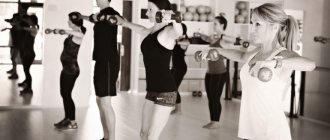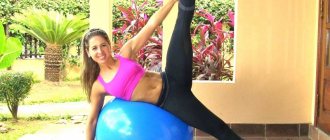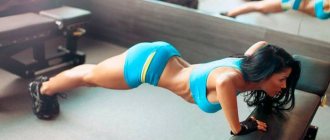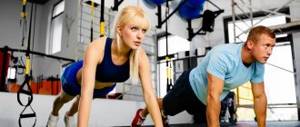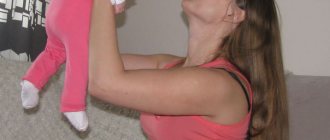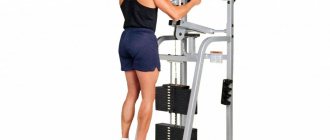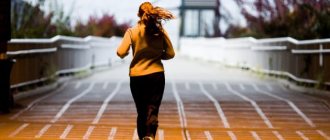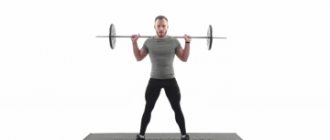Example of a training program for teenagers 15-17 years old
The training program for teenagers, which is proposed below, has one feature: in it we work the whole body in one day. This is called circuit training. Exercise 3 times a week. Such training usually gives teenagers good results.
- Bench press – 3x12
- Dips 3x14
- Pull-ups - maximum number of times 3xmax
- Barbell squats (start with small weights and under the supervision of a trainer) 3x12
- Hyperextension 3x20
- Hanging leg raise 3z12
Example of a training program for guys 17-19 years old
Split training (2 muscle groups per day) 3 times a week.
Day 1 (chest, biceps)
- Bench press 3x8 (+ 2 warm-up sets required)
- Incline Dumbbell Press 3x8
- Push-ups on wide bars 3xmax
- Hanging leg raise 3xmax
- Standing biceps curl 3x8
- Scott bench 3x8
Day 2 (back, triceps)
- Deadlift 3x10 (with 2 warm-up approaches)
- Pull-ups 4xmax
- Shrugs 3x10
- Dips 3xmax
- French press 3x8
Day 3 (legs, shoulders)
- Squats 3x10 (with warm-up)
- Leg press 3x8
- “Donkey” 3x15
- Seated dumbbell press 3x10
- Standing barbell press 3x10
- Crunches 3xmax
We also strongly recommend watching this video - there will be a lot of useful information from experienced athletes specifically for teenagers. The specifics of training for young athletes will be considered, the main problems they may encounter and warnings:
Finally, I would like to remind you about the correct technique for performing exercises.
This is especially important during adolescence because it is very easy to get injured. Learn the technique of performing all the exercises you are going to use, especially the basic ones! Download Best WordPress Themes Free Download
Gymnastics (acrobatics). Circuit training, relay races.
Divide the class into 4 groups, appoint a commander in each group. Students released from classes are distributed to stations where they provide assistance at the stations. They give everyone cards with creatures. They give points on a card, according to a 5-point system, for the work they have completed, which students provide at each station. Each station is allocated 30 seconds, rest between tasks is 15-20 seconds. Just 1 lap.After finishing the circuit training, summing up the results.
Execution technique. Squatting from the stop, straightening your legs, transfer the weight of your body to your arms, tilt your head forward; bending your arms, push off with your legs and roll over your head - group; perform a point-blank roll while crouching - stand up). When mastering a forward somersault, the student must know the following rules: 1. When leaning on your hands, you must fully extend your legs at the knees. 2. Bringing your shoulders forward, tilt your head to your chest. 3. Pushing off with your feet, group yourself by grabbing the middle of your shins with your hands. The student must be able to: 1. Perform tight grouping. 2. Perform a tuck roll.
Slide 2
Execution technique. From an emphasis, crouching - feet hip-width apart, shoulders slightly forward, group; tilt your head forward, pushing off with your hands, quickly roll onto your shoulder blades and, leaning your hands behind your shoulders, roll over your head; straightening your arms, go into a crouching position.
When mastering the back somersault, the student must know the following rules:
1. In a crouched position, you need to move your shoulders forward. 2. When rolling back, keep a tight tuck until your neck touches the mat and supports with your hands behind your shoulders. 3. Start extending your arms before your feet touch the mat.
The student must be able to:
Quickly roll back in a tuck and rest your hands behind your shoulders.
Slide 3
Preparatory phase: hands with fingers spread freely grasp the ball held at waist level, elbows are lowered. With a circular movement of the hands, the ball is pulled towards the chest.
Main phase: the ball is sent forward with a sharp straightening of the arms almost to failure, complemented by movement of the hands, giving the ball a reverse rotation.
Final phase: after the pass, the arms are relaxed, the player straightens up, and then takes a position on slightly bent legs (this final phase is typical for other methods of passing).
If the opponent actively interferes with the pass at chest level, then the ball can be sent so that, upon hitting the court near the partner, it bounces straight to him. To make the ball bounce quickly, they sometimes give it forward rotation. During such a pass, the legs need to be bent more, and the hands with the ball should be directed forward and down.
Pay attention to the technique of catching the ball, passing the ball at chest level, receiving the ball facing your partner. The distance from each other is 3 meters.
Slide 4
Passing the ball with one hand (bent) from the shoulder with a push is the fastest and most accurate pass over short and medium distances. The hand with the ball is retracted to the right shoulder (when passing with the right hand) and at the same time rotated so that the hand is behind the ball. By straightening his right arm and sharply bending his wrist, the player passes the ball in the desired direction
Slide 5
Do not bend your legs under you, perform jumps on two legs. The technique of basic jumping rope is very simple. Hold the rope at hip or waist level with your palms facing your body. Begin each jump with a slight bend in the knees, and all jumps should be performed using the ball of the foot. When jumping rope, your back should be straight and your abdominal muscles tense. Try not to jump high, 2 – 4 cm is the optimal height for intense training.
Slide 6
Instructions for implementation:
To perform the exercise, you need to lie on the floor and fix your legs bent at the knees with something, or ask someone to hold them for you. Place your hands behind your head and interlock your fingers. This is the starting position;
As you exhale, lift your upper body so that it forms an imaginary V with your hips;
Take a short pause, tensing your muscles, then inhale and return to the starting position;
Complete the recommended number of repetitions;
Slide 7
